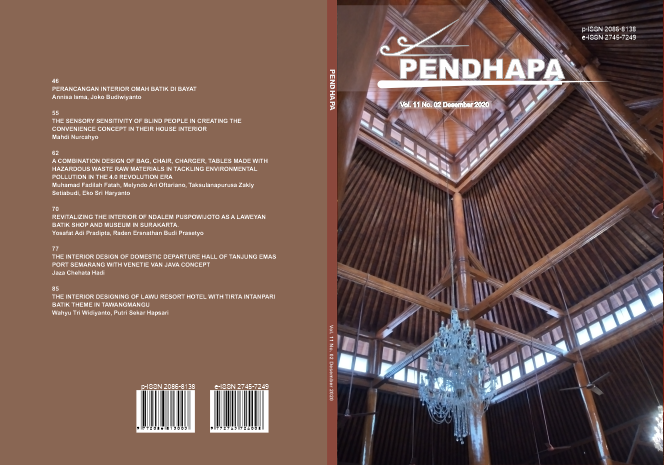Revitalizing the Interior of Ndalem Puspowijoto as a Laweyan Batik Shop and Museum in Surakarta.
DOI:
https://doi.org/10.33153/pendhapa.v11i2.3618Keywords:
Revitalization, Interior, Shop, Museum, Art DecoAbstract
Revitalizing the Interior of Ndalem Puspowijoto as a Batik Shop and Museum in Laweyan Surakarta is an effort to preserve cultural heritage buildings. The revitalization aims to maintain the building and as a means of education about batik and local wisdom of Laweyan village for the visitors and general public who care about batik. The design process is carried out using Kurtz programming including the orientation stage, the base program stage, interative programming, and design as feedback. The design approach uses the Art Deco style with the theme of Parang Saudagar. The results of the revitalization are in the form of the museum that can be used for educational purposes, and Laweyan Batik shop which has a place that is comfortable, safe, and able to accommodate the needs of both managers and visitors. The facilities consist of a lobby, café, deposit counter, shop, ticketing room, digital audio education, main display, fabric display, item display, maintenance room, multipurpose room, pantry, toilet, office, and prayer room.
Downloads
References
Anonim. n.d. Peraturan Menteri Perdagangan Republik Indonesia Tentang Pedoman Penataan Dan Pembinaan Pasar Tradisional, Pusat Perbelanjaan Dan Toko Modern.
Astrid Kusumowidagdo. 2005. “PERAN PENTING PERANCANGAN INTERIOR PADA STORE BASED RETAIL.” Dimensi Interior 3 (1).
Ching, Francis DK. 1996. Ilustrasi Desain Interior. Jakarta: Erlangga.
Gumulya, Devanny. 2020. “DESAIN PRODUK DENGAN INSPIRASI ART DECO EROPA ERA TAHUN 1920 DENGAN PENDEKATAN CHART MORFOLOGI.” Jurnal Patra 2 (2). https://doi.org/10.35886/patra.v2i2.114.
Hamzah, Faizal, and Eko Tri Utomo. 2016. “Sapta Pesona Pada Museum Mandala Wangsit Siliwangi Kota ImplementasiBandung.” Jurnal Pariwisata III (2).
Jeanne Allen. 1986. Designer’s Guide to Color 3. San Francisco: Chronicle Books.
Kotler, Philip. 2003. Marketing Insights from A to Z : 80 Concepts Every Manager Needs to Know. New Jersey: John Wiley & Sons, Inc.
Krisnina Maharani Tandjung. 2002. Rumah Solo, Rumah-Rumah Klasik Paduan Kultur Jawa Eropa. Singapore: Times Media Private Editions.
Kusumastuti, Kusumastuti. 2017. “PROSES DAN BENTUK ‘MEWUJUDNYA’ KOTA SOLO BERDASARKAN TEORI CITY SHAPED SPIRO KOSTOF.” Region: Jurnal Pembangunan Wilayah Dan Perencanaan Partisipatif 7 (1). https://doi.org/10.20961/region.v7i1.5782.
Lokaprasidha, Pramesi. 2017. “The History of Batik and The Development of Kampung Batik Kauman as a Local to International Tourism Destination.” Journal of Tourism and Creativity 1 (1).
Mangedaby, Eva Artmey, Bambang Setioko, and Suzanna Ratih Sari. 2017. “Pengaruh Desa Wisata Kampoeng Batik Laweyan Terhadap Fungsi Permukiman Di Kelurahan Laweyan Kota Surakarta.” Teknik 38 (1). https://doi.org/10.14710/teknik.v38i1.12057.
Mlayadipuro. 1984. Sejarah Kyai Ageng AnisKyai Ageng Laweyan, Urip – Urip. Surakarta: Museum Radya Pustaka.
Ratnawati, Anista Yulia, and Edy Susena. 2017. “Analisis Manajemen Pemasaran Batik Di Kampoeng Batik Laweyan Surakarta.” Jurnal INFORMA Politeknik Indonusa Surakarta 3.
Rudiatmo, FX. HAdi. 2013. Benda Cagar Budaya (BCB). Surakarta.
Salayanti, Santi. 2018. “ANALISA POLA BUDAYA SUNDA PRIMODIAL (Pola Tiga) PADA TATA RUANG DAN BENDA PAJANG DI MUSEUM NEGERI JAWA BARAT SRI BADUGA BANDUNG.” Idealog: Ide Dan Dialog Desain Indonesia 2 (1). https://doi.org/10.25124/idealog.v2i1.1176.
Sulthon, Muhammad. 2016. “Redesain Museum Purbakala Patiayam Kudus. Laporan Tugas Akhir.” Semarang.
Sumarno, and Indarto. 2016. “Implementasi Prinsip Quadrow Helix Dalam Rancang Bangun Show Room Di Sentra Industri Kerajinan Rotan Sukoharjo.” Surakarta.
Suptandar, J.Pamudji. 1982. Perancangan Tata Ruang Dalam (Interior Design). Jakarta: Penerbit PT Djambatan.
Downloads
Published
Issue
Section
License
Authors who publish with Pendhapa agree to the following terms:
- Authors retain copyright and grant the journal right of first publication with the work simultaneously licensed under a Creative Commons Attribution License (CC BY-SA 4.0) that allows others to share the work with an acknowledgment of the work's authorship and initial publication in this journal.
- Authors are able to enter into separate, additional contractual arrangements for the non-exclusive distribution of the journal's published version of the work (e.g., post it to an institutional repository or publish it in a book), with an acknowledgment of its initial publication in this journal.
- Authors are permitted and encouraged to post their work online (e.g., in institutional repositories or on their website) prior to and during the submission process, as it can lead to productive exchanges, as well as earlier and greater citation of published work.

This work is licensed under a Creative Commons Attribution-ShareAlike 4.0 International License.









